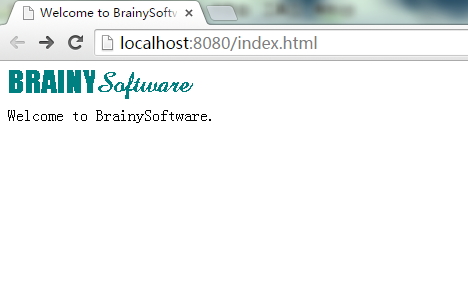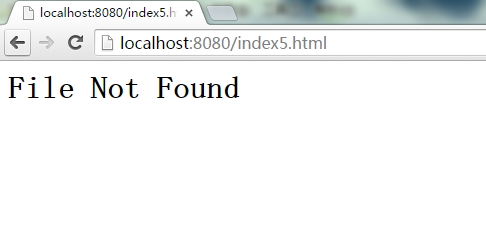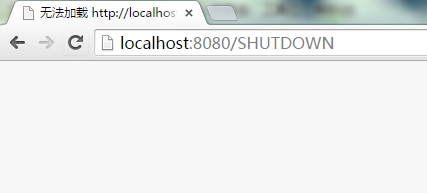一個簡單的Java web服務器實現,比較簡單,基於java.net.Socket和java.net.ServerSocket實現;
服務器實現:
package ex01.pyrmont;
import java.net.Socket;
import java.net.ServerSocket;
import java.net.InetAddress;
import java.io.InputStream;
import java.io.OutputStream;
import java.io.IOException;
import java.io.File;
public class HttpServer {
/**
* WEB_ROOT是HTML和其它文件存放的目錄. 這裡的WEB_ROOT為工作目錄下的webroot目錄
*/
public static final String WEB_ROOT = System.getProperty("user.dir") + File.separator + "webroot";
// 關閉服務命令
private static final String SHUTDOWN_COMMAND = "/SHUTDOWN";
public static void main(String[] args) {
HttpServer server = new HttpServer();
//等待連接請求
server.await();
}
public void await() {
ServerSocket serverSocket = null;
int port = 8080;
try {
//服務器套接字對象
serverSocket = new ServerSocket(port, 1, InetAddress.getByName("127.0.0.1"));
} catch (IOException e) {
e.printStackTrace();
System.exit(1);
}
// 循環等待一個請求
while (true) {
Socket socket = null;
InputStream input = null;
OutputStream output = null;
try {
//等待連接,連接成功後,返回一個Socket對象
socket = serverSocket.accept();
input = socket.getInputStream();
output = socket.getOutputStream();
// 創建Request對象並解析
Request request = new Request(input);
request.parse();
// 檢查是否是關閉服務命令
if (request.getUri().equals(SHUTDOWN_COMMAND)) {
break;
}
// 創建 Response 對象
Response response = new Response(output);
response.setRequest(request);
response.sendStaticResource();
// 關閉 socket 對象
socket.close();
} catch (Exception e) {
e.printStackTrace();
continue;
}
}
}
}
Request類:
package ex01.pyrmont;
import java.io.InputStream;
import java.io.IOException;
public class Request {
private InputStream input;
private String uri;
public Request(InputStream input) {
this.input = input;
}
//從InputStream中讀取request信息,並從request中獲取uri值
public void parse() {
StringBuffer request = new StringBuffer(2048);
int i;
byte[] buffer = new byte[2048];
try {
i = input.read(buffer);
} catch (IOException e) {
e.printStackTrace();
i = -1;
}
for (int j = 0; j < i; j++) {
request.append((char) buffer[j]);
}
System.out.print(request.toString());
uri = parseUri(request.toString());
}
/**
*
* requestString形式如下:
* GET /index.html HTTP/1.1
* Host: localhost:8080
* Connection: keep-alive
* Cache-Control: max-age=0
* ...
* 該函數目的就是為了獲取/index.html字符串
*/
private String parseUri(String requestString) {
int index1, index2;
index1 = requestString.indexOf(' ');
if (index1 != -1) {
index2 = requestString.indexOf(' ', index1 + 1);
if (index2 > index1)
return requestString.substring(index1 + 1, index2);
}
return null;
}
public String getUri() {
return uri;
}
}
Response類:
package ex01.pyrmont;
import java.io.OutputStream;
import java.io.IOException;
import java.io.FileInputStream;
import java.io.File;
/*
HTTP Response = Status-Line
*(( general-header | response-header | entity-header ) CRLF)
CRLF
[ message-body ]
Status-Line = HTTP-Version SP Status-Code SP Reason-Phrase CRLF
*/
public class Response {
private static final int BUFFER_SIZE = 1024;
Request request;
OutputStream output;
public Response(OutputStream output) {
this.output = output;
}
public void setRequest(Request request) {
this.request = request;
}
public void sendStaticResource() throws IOException {
byte[] bytes = new byte[BUFFER_SIZE];
FileInputStream fis = null;
try {
//將web文件寫入到OutputStream字節流中
File file = new File(HttpServer.WEB_ROOT, request.getUri());
if (file.exists()) {
fis = new FileInputStream(file);
int ch = fis.read(bytes, 0, BUFFER_SIZE);
while (ch != -1) {
output.write(bytes, 0, ch);
ch = fis.read(bytes, 0, BUFFER_SIZE);
}
} else {
// file not found
String errorMessage = "HTTP/1.1 404 File Not Found\r\n" + "Content-Type: text/html\r\n"
+ "Content-Length: 23\r\n" + "\r\n" + "<h1>File Not Found</h1>";
output.write(errorMessage.getBytes());
}
} catch (Exception e) {
// thrown if cannot instantiate a File object
System.out.println(e.toString());
} finally {
if (fis != null)
fis.close();
}
}
}
訪問存在的資源文件(注意存放在工程目錄的webroot文件夾裡):

訪問不存在的資源文件:

關閉服務器:

參考資料:《深入剖析Tomcat》